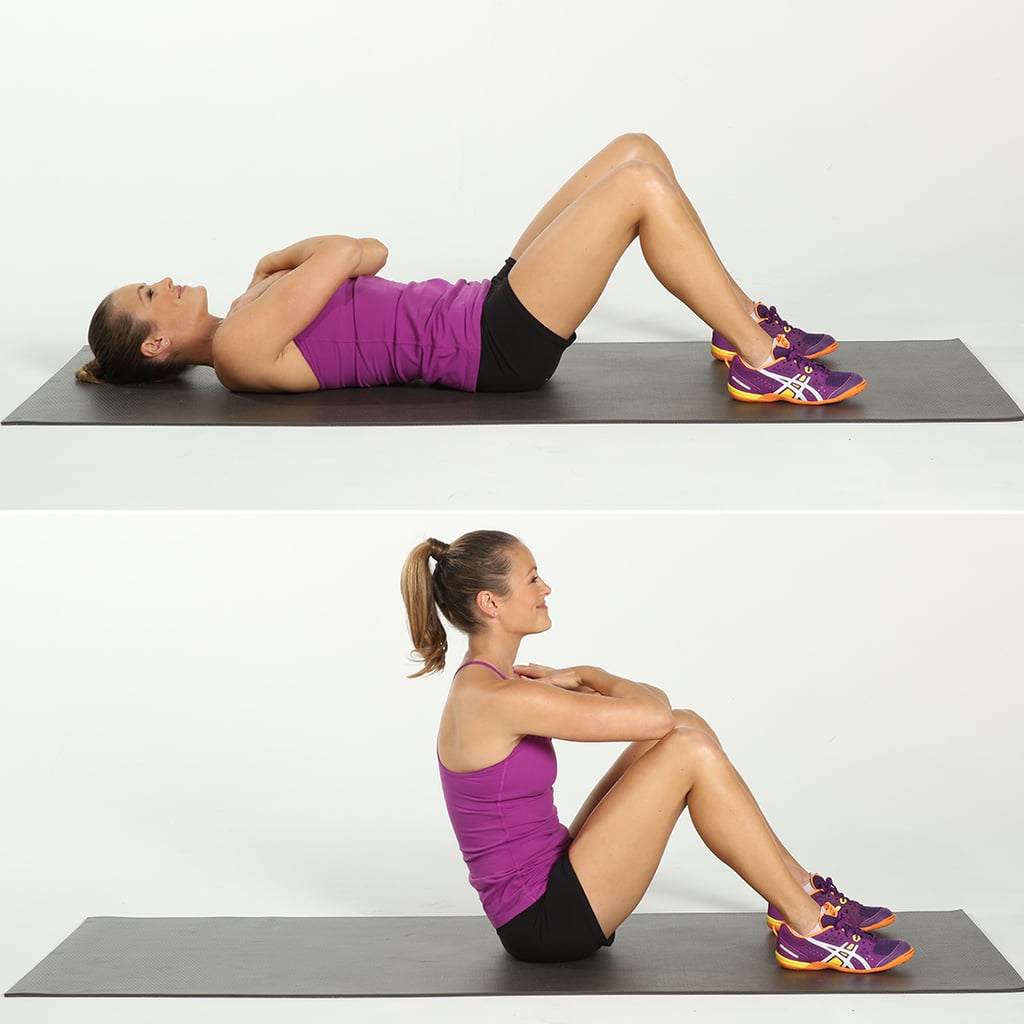The Multi-Faceted Benefits of Sit-Ups: A Holistic Approach
Sit-ups are a popular exercise for strengthening and toning the core, primarily targeting the abdominal muscles, obliques, and hip flexors. Proper form and technique are crucial for maximizing the benefits of sit-ups and minimizing the risk of injury. This versatile exercise contributes to overall strength and stability, making it an essential component of any well-rounded fitness routine.
When executed correctly, sit-ups engage multiple muscle groups, making them an effective way to improve core strength and muscle definition. The primary muscles worked during sit-ups include the rectus abdominis, which runs down the front of the abdomen and is responsible for the “six-pack” appearance, and the obliques, which are located on the sides of the abdomen and aid in rotation and lateral flexion.
Additionally, sit-ups engage the hip flexors, a group of muscles responsible for lifting the thighs towards the body. Strengthening the hip flexors can contribute to improved posture, stability, and functional movement in daily activities. By focusing on proper form and engaging these muscle groups, individuals can reap the full benefits of sit-ups and create a strong, toned core.
Demystifying the Core: The Anatomy of the Abdominal Muscles
The core is a complex network of muscles that work together to provide stability, balance, and strength to the body. The primary muscles responsible for the “sit ups muscles worked” effect are the abdominal muscles, which consist of several layers:
- Rectus Abdominis: The most superficial of the abdominal muscles, the rectus abdominis is a long, flat muscle that runs vertically along the front of the abdomen. It is responsible for flexing the spine and is often targeted during sit-ups to achieve a toned, six-pack appearance.
- Obliques: Located on the sides of the abdomen, the obliques are responsible for lateral flexion (side bending) and rotation of the torso. The external obliques are the most superficial, while the internal obliques lie deeper. Both muscles work together to create a strong, stable core and contribute to overall strength and stability.
- Transverse Abdominis: The deepest of the abdominal muscles, the transverse abdominis wraps horizontally around the abdomen, acting as a natural weightlifting belt. It plays a crucial role in stabilizing the spine and pelvis, protecting the lower back, and maintaining proper posture.
Sit-ups primarily engage the rectus abdominis and obliques, with the hip flexors also playing a significant role. As the body moves through the sit-up motion, these muscles contract and relax in a coordinated effort to lift the torso off the ground and lower it back down. By understanding the anatomy of the core and the muscles involved in sit-ups, individuals can better appreciate the importance of proper form and technique for maximizing muscle activation and achieving their fitness goals.
How to Perform Sit-Ups Correctly: A Step-by-Step Guide
To maximize the benefits of sit-ups and ensure proper engagement of the targeted muscles, follow these steps:
- Lie down: Begin by lying flat on your back with your knees bent and feet flat on the floor, approximately hip-width apart. Place your hands behind your head or cross them over your chest, whichever feels more comfortable and natural.
- Engage your core: Before initiating the sit-up, brace your core by contracting your abdominal muscles as if preparing to take a punch. This engagement helps protect your lower back and ensures that the correct muscles are working during the exercise.
- Lift your torso: Slowly curl your torso upwards, leading with your chest and keeping your neck in a neutral position. Aim to lift your upper body off the ground just enough to clear your shoulder blades. Avoid pulling on your head or neck, as this can lead to strain or injury.
- Lower back down: Slowly and controlled, return your torso to the starting position, maintaining core engagement throughout the movement. Ensure that your lower back remains in contact with the ground at all times to prevent unnecessary strain.
- Repeat: Perform the desired number of repetitions, focusing on proper form and technique. Aim for 10-15 repetitions to start, gradually increasing the number as your strength and endurance improve.
By following this step-by-step guide, you can ensure that you are performing sit-ups correctly, thereby maximizing the engagement of the “sit ups muscles worked” and minimizing the risk of injury. Remember to maintain a steady breathing pattern throughout the exercise, inhaling as you lower and exhaling as you lift.
Maximizing Muscle Activation: Variations and Progressions of Sit-Ups
To keep your sit-up workouts engaging and challenging, consider incorporating various sit-up variations and progressions that target different muscle groups. This approach allows you to tailor your workouts to your specific needs and goals, ensuring that you continue to make progress and avoid plateaus.
1. Traditional Sit-Ups
Traditional sit-ups primarily target the rectus abdominis, the long, flat muscle that runs down the front of the abdomen. To perform traditional sit-ups, lie flat on your back with your knees bent and feet flat on the floor, hip-width apart. Place your hands behind your head or cross them over your chest. Curl your torso upwards, leading with your chest, and then slowly lower yourself back down. Aim for 10-15 repetitions.
2. Twisting Sit-Ups
Twisting sit-ups engage the obliques, the muscles located on the sides of the abdomen responsible for lateral flexion and rotation of the torso. To perform twisting sit-ups, follow the same steps as traditional sit-ups but twist your torso towards the opposite knee as you lift, alternating sides with each repetition.
3. Reverse Sit-Ups
Reverse sit-ups target the lower abs, the region of the rectus abdominis below the navel. To perform reverse sit-ups, lie flat on your back with your arms at your sides, palms down. Lift your legs perpendicular to the floor, keeping them straight. Lower your legs, maintaining control, until they are just above the ground. Lift your legs back up to the starting position, completing one repetition.
4. Decline Sit-Ups
Decline sit-ups increase the resistance on the rectus abdominis by elevating the feet, making them more challenging than traditional sit-ups. To perform decline sit-ups, position yourself on a decline bench with your feet secured. Follow the same steps as traditional sit-ups, focusing on maintaining proper form and technique.
5. Weighted Sit-Ups
Adding weight to sit-ups can further challenge the rectus abdominis and increase muscle activation. Hold a weight plate, dumbbell, or medicine ball against your chest or place it behind your head. Perform sit-ups as usual, focusing on controlled movements and proper form.
By incorporating these variations and progressions into your sit-up workouts, you can keep your routine fresh, engaging, and effective. Remember to always prioritize proper form and technique, gradually increasing the difficulty as your strength and endurance improve.
Incorporating Sit-Ups into a Well-Rounded Fitness Routine
Sit-ups are a versatile exercise that can contribute to overall strength, flexibility, and balance when integrated into a comprehensive fitness program. By understanding the role of sit-ups in targeting various muscle groups, you can effectively incorporate them into your workouts to enhance your core strength and overall fitness.
Designing a Balanced Workout Routine
A well-rounded fitness routine typically includes exercises that target different muscle groups, such as the legs, chest, back, shoulders, and arms. Sit-ups can be a valuable addition to your routine, focusing on the abdominals, obliques, and hip flexors. To ensure a balanced approach, aim to include exercises that work all major muscle groups in your workouts.
Sample Workout Routines
Here are two examples of workout routines that incorporate sit-ups and related exercises:
- Workout A:
- Warm-up: 5-10 minutes of light cardio (jogging, cycling, or jumping jacks)
- Sit-ups: 3 sets of 15-20 repetitions
- Bodyweight squats: 3 sets of 15-20 repetitions
- Push-ups: 3 sets of 10-15 repetitions
- Pull-ups or assisted pull-ups: 3 sets of 8-12 repetitions
- Overhead press: 3 sets of 10-15 repetitions
- Cool-down: 5-10 minutes of stretching
- Workout B:
- Warm-up: 5-10 minutes of light cardio (jogging, cycling, or jumping jacks)
- Twisting sit-ups: 3 sets of 15-20 repetitions
- Lunges: 3 sets of 10-15 repetitions per leg
- Dumbbell bench press: 3 sets of 10-15 repetitions
- Bent-over rows: 3 sets of 10-15 repetitions
- Lateral raises: 3 sets of 10-15 repetitions
- Cool-down: 5-10 minutes of stretching
By alternating between Workout A and Workout B, you can create a balanced fitness program that includes sit-ups and targets all major muscle groups. Remember to adjust the number of sets and repetitions based on your fitness level and goals, gradually increasing the difficulty as you progress.
Beyond Sit-Ups: Complementary Exercises for a Stronger Core
While sit-ups are an effective exercise for targeting the abdominal muscles, incorporating a variety of complementary exercises into your routine can further strengthen and tone your core. A diverse range of core exercises ensures that you engage all the muscles in your midsection, promoting overall strength, stability, and balance.
Bodyweight Core Exercises
Bodyweight core exercises are an excellent way to build strength and endurance without requiring any special equipment. Some examples of bodyweight core exercises include:
- Plank: Hold a high plank position, with your hands shoulder-width apart and your body forming a straight line from your head to your heels. Engage your core and maintain a neutral spine. Aim for 30-60 seconds, gradually increasing the duration as you progress.
- Bicycle crunches: Lie flat on your back with your hands behind your head. Lift your head and shoulders off the ground and alternate bringing each elbow to the opposite knee, creating a “pedaling” motion with your legs. Perform 15-20 repetitions on each side.
- Reverse crunches: Lie flat on your back with your arms at your sides. Lift your legs off the ground, keeping them bent at a 90-degree angle. Use your core to curl your hips off the ground, bringing your knees towards your chest. Perform 15-20 repetitions.
Equipment-Based Core Exercises
Incorporating equipment-based core exercises into your routine can add variety and challenge, further engaging your muscles and promoting overall strength and stability. Some equipment-based core exercises include:
- Cable crunches: Using a cable machine, pull the cable down towards your chest, keeping your core engaged and your spine neutral. Perform 12-15 repetitions.
- Hanging leg raises: Hang from a pull-up bar with your hands shoulder-width apart. Engage your core and use your abs to lift your legs towards the bar, keeping them straight. Perform 10-15 repetitions.
- Medicine ball slams: Hold a medicine ball with both hands and lift it above your head. Slam the ball down onto the ground with force, engaging your core and using your whole body to generate power. Perform 12-15 repetitions.
By incorporating a mix of bodyweight and equipment-based core exercises into your routine, you can create a well-rounded workout program that targets all the muscles in your midsection, promoting overall strength, stability, and balance.
Setting Realistic Goals and Tracking Progress: A Practical Approach
Setting realistic goals and tracking progress are essential components of any successful workout program, including sit-ups and core training. By establishing clear objectives and monitoring your development, you can maintain motivation, ensure consistency, and achieve long-term success.
Establishing Realistic Goals
To set realistic goals for your sit-up workouts, consider the following guidelines:
- Be specific: Clearly define what you want to achieve, such as increasing your sit-up count by a certain number or performing a specific variation.
- Be realistic: Set achievable goals based on your current fitness level and capabilities. Gradual progression is key to long-term success.
- Set a timeline: Assign a deadline to your goals, providing structure and motivation to your workout plan.
Tracking Progress
To effectively track your progress in sit-ups and core training, consider the following methods:
- Workout journal: Record your workouts in a dedicated journal, noting the exercises, sets, repetitions, and any variations or progressions. Regularly review your journal to monitor your development and identify areas for improvement.
- Fitness apps: Utilize fitness apps to log your workouts, set goals, and track your progress over time. Many apps also offer workout plans, exercise demonstrations, and community features to enhance your experience.
- Performance tests: Periodically perform tests to assess your strength, endurance, and technique. For example, you can time yourself while performing as many sit-ups as possible in one minute or evaluate your form in front of a mirror to ensure proper execution.
By setting realistic goals and consistently tracking your progress, you can maintain motivation, ensure consistency, and achieve long-term success in your sit-up workouts and core training.
Overcoming Challenges and Staying Motivated: Tips and Tricks
Maintaining motivation and overcoming challenges are essential aspects of any fitness journey, including sit-up workouts. Here are some practical tips and tricks to help you stay committed and engaged during your sit-up routine:
1. Set clear goals: Defining specific, measurable, achievable, relevant, and time-bound (SMART) goals for your sit-up workouts can provide a clear sense of direction and purpose. Break down your long-term objectives into smaller, short-term milestones to track your progress and celebrate small victories along the way.
2. Mix it up: Incorporate various sit-up variations and complementary exercises (sit ups muscles worked) to keep your workouts interesting and engaging. This not only helps prevent boredom but also ensures that you are targeting different muscle groups for a well-rounded core workout.
3. Create a workout schedule: Establishing a consistent workout routine can help you stay on track and make sit-ups a regular part of your fitness regimen. Be realistic about your time commitments and plan your workouts accordingly. Consider using a planner or digital calendar to organize your schedule and hold yourself accountable.
4. Find a workout buddy: Exercising with a friend or family member can help you stay motivated and accountable. Additionally, it can make your workouts more enjoyable and provide an opportunity for friendly competition, pushing you to perform at your best.
5. Track your progress: Regularly monitoring your progress can help you identify areas for improvement and provide a sense of accomplishment as you reach your goals. Consider using a fitness app, journal, or spreadsheet to document your workouts, including the number of sit-ups, variations, and any changes in your strength or endurance.
6. Be patient: Building core strength and endurance takes time and dedication. Acknowledge that setbacks and plateaus are a natural part of the process and focus on maintaining consistency and patience. Remember that the journey is just as important as the destination, and every step you take brings you closer to your goals.
7. Stay positive: Maintaining a positive attitude can help you overcome challenges and stay motivated during your sit-up workouts. Focus on the benefits of sit-ups, such as improved posture, increased strength, and enhanced core stability, and remind yourself of your commitment to your health and fitness goals.
8. Manage your time effectively: Prioritize your sit-up workouts by scheduling them during your most productive hours or incorporating them into your daily routine. For example, try doing sit-ups while watching TV or listening to your favorite podcast. By making the most of your time, you can ensure that your workouts are both efficient and enjoyable.








